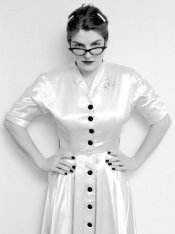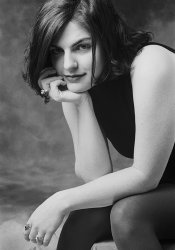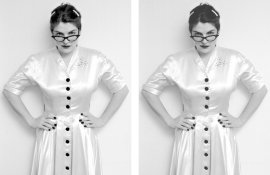Even if you're viewing prints on a computer monitor, you're viewing scanned prints. It's probably more informative to view the scanned negs, as that's your raw data right there. Your prints are gonna be all over the place, depending on how they were processed, what type of paper and filtration was used, etc. What you see on any image, and what I see, depend on our monitors, and they're all a little different. Some are a lot different. So all we're looking for is a basic idea. I use a Sony Trinitron CRT monitor, my wife has one of those new fangled flat screen thingies. The same images look very different on them.
Those images you linked to should be easy to duplicate if you use decent lighting and similar film and subjects. Who knows what they look like in real life anyway? I'm not crazy about two of the portraits above (because there's no accounting for personal taste) but really like the middle image, even though that's not what you're after. I do a lot of portraits, and one thing that's for real is it's all about your subject. The other stuff is important, but secondary. Give me an old fuzzy grab shot of Sophia Loren over a professional studio shot of Phylis Diller any day. Don't take my comment personally smieglitz, I don't like 99% of my own work.
Want to have some fun? Take a sitter, put them in the same place in the same light, and shoot them w/ the same film and lens by moving around them as you shoot at different angles and slightly different distances. Use at least 2 rolls of film (3 or 4 is ideal), then process them exactly the same way. Every single image will be different, and some won't necessarily even look like the same person! Why? Reality is not fixed, it's ever changing moment by moment, and unless we stop the flow of time w/ a shutter, our eyes and brain are so accustomed to these subtle changes that we tune them out. Right now my CRT monitor is flickering like crazy but I don't see it unless I turn my head to the side. That's the wonderful thing about art. We find out very quickly that once we get us out of the way, and just observe what's in front of us, that none of what we see is really there. It's not at all what it looks like, it's just what it looks like to YOU at that particular instant in time. To ME, it looks somewhat different, and it will look different tomorrow, the next day, etc. This really, really, bothers some people that like things to stay the same way. They will often get very obstructive and disagreeable. Many people on the internet are like this, to one degree or another. It's how differences in perceptions lead to arguments. Our state of mind and memories can greatly alter our perception of visual realty as well.














 I hope my reply wasn't received as negative in any way.
I hope my reply wasn't received as negative in any way.